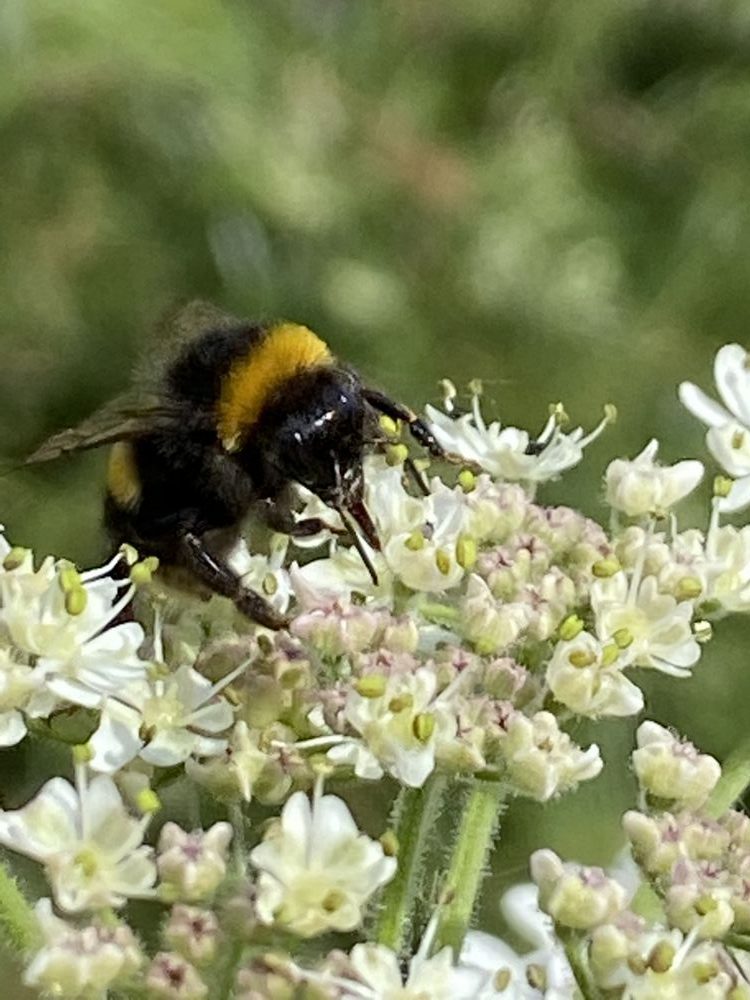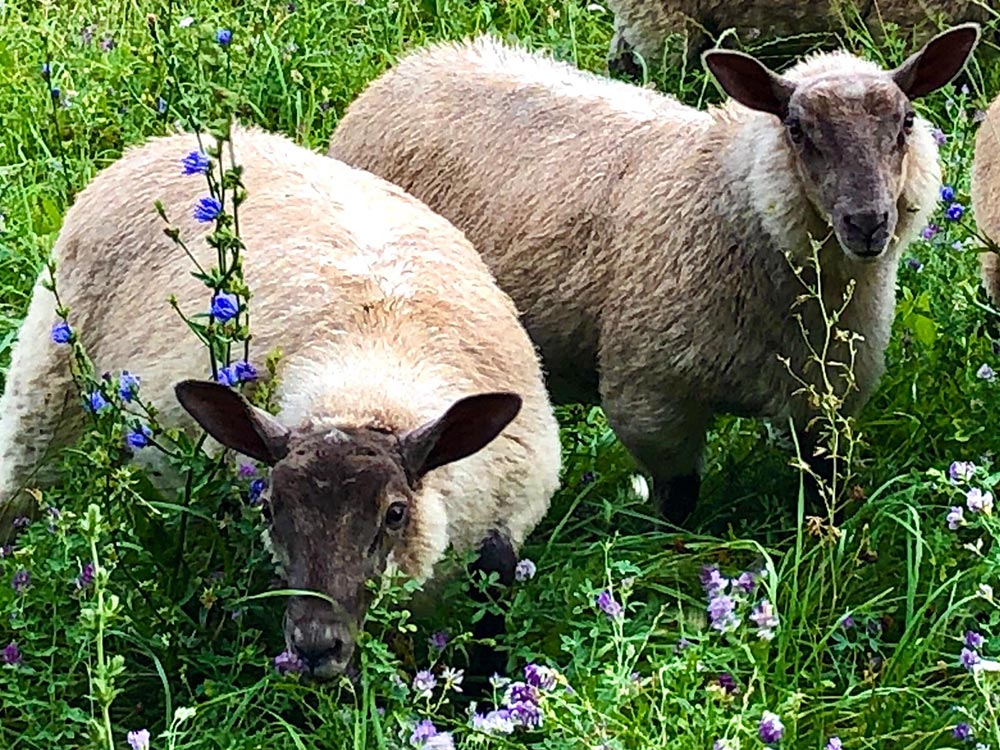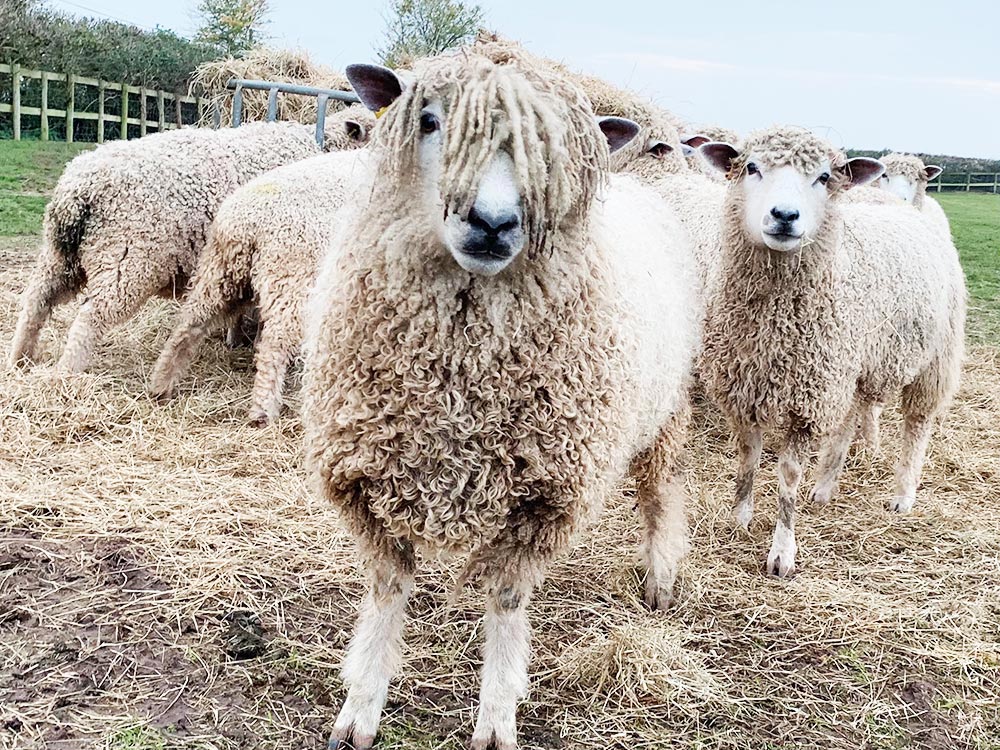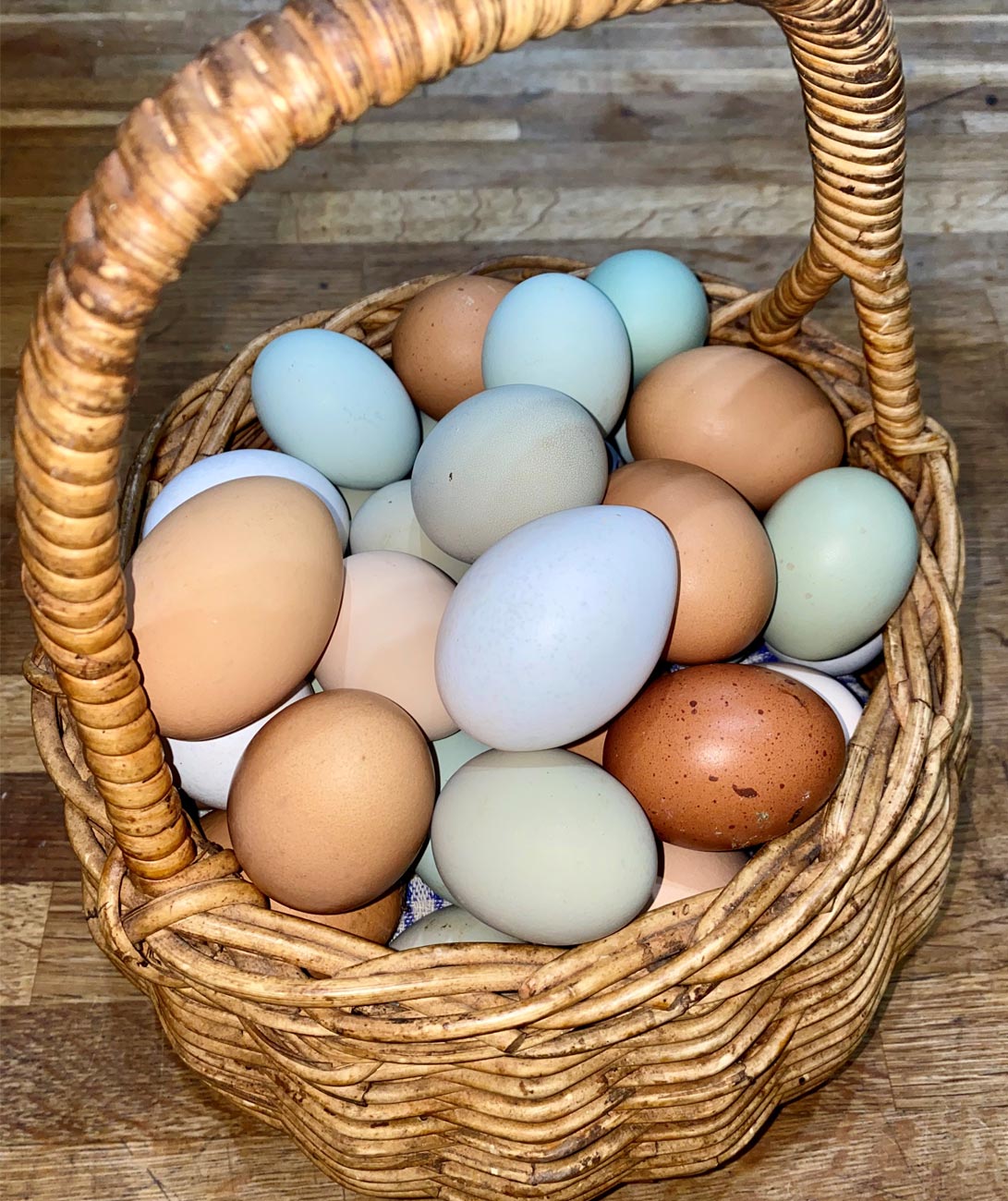Bees
We currently have a single Flohive 2 of which we expand again in the Spring of 2021 to add an extra nucleus.
This whole experience is something very new to us and very much educated by our mentor Chris Manton and wife who are guiding us through the ever-increasing complex understanding of beekeeping. Fortunately, we have an incredibly diverse selection of pollen to feed the bees throughout the season from the early dandelion and apple blossoms, through cover crops and wildflower margins right through to ivy towards the end of the foraging season. Interestingly enough we are also plagued by the invasive Himalayan balsam Impatiens glandulifera along the banks of the River Wye and the stream and ditches that feed it from around the farm, yet provide a very good nectar source for the bee colony during the Autumn.
The Flo Hive experience allows for novices to collect honey relatively easily and when our farm experiences are up and running, this will be an option that can be selected.
As the colonies expand, we will look to market our own regenerative honey in the farm shop and online delivery store.
Sheep
A flock that very much started with our youngest daughter Erin. As the female contingent of the clan, Erin always struggled with confidence when around horses, several ponies of various ages and breeds resulted eventually in the acceptance that horses were not for her. As an animal lover Erin wanted something that she could ‘show’ as she enjoyed grooming. As someone who had kept sheep previously, and lambed many ewes back in the years when Townsend was a mixed farm, it was decided that some native to Herefordshire Ryeland sheep would be purchased (3 in number) of which we kept. Erin groomed and indeed showed and won various rosettes. Lambing time was somewhat frustrating (for someone that was previously used to lambing 500 ewes) and the nightly vigil finally produced a few good lambs but the return on effort meant we felt looking forward it was either none or 50+ to make a decent return on effort.
Rare breeds… How many? So it made sense to increase the Ryeland flock, which was done to 22 ewes. Nicola wanted Kerry Hills and Dorset Downs so we purchased 20 ewes of those too. I wanted a couple of breeds that were sort after for their quality of wool, to try and provide some diversity of income, so we purchased some Leicester Longwools and Teeswater, bringing a mixed flock size to 80 ewes for 2021 April lambing.
It was at this point our friends, the Richardson-Wall family, admitted they were looking at renting some land to keep some sheep themselves and we had a conversation about the future of animals and how it might work at Townsend. We were lacking help to move animals on a mob grazing system and they were intrigued about how the system works and combined with their interest in animals we set about deciding where investment in sheep could be made.
Rare breeds or commercial? This was a rather simple decision for us because we believe in the specific breeding of animals throughout history, their protection for future generations and also the satisfaction of producing sheep that had desired traits of either fleece or meat which provide much interest in their upkeep. It will be interesting to compare the rare breed production with a commercial flock in terms of profitability – often profitability is ignored in favour of finished lambs produced – much like cropping looking at yield rather than profit!
We have hired Tups for the ewes for this autumn and obviously had to split all of the breeds up whilst the Tups have gone to work. Tupping is a very traditional timing for us where the tups are introduced on “Guy Fawkes” for an “April Fool” lambing
The ewes will be put back together after finishing their double 3-week cycle and be mob grazed throughout the winter on the cover crops that have established on any of the farm’s fields that are destined for spring cropping. Whilst any nutrient deficiency will be met by their very own free choice mineral trailer that can be moved with the trailer.
Lambing will be an exciting time on the farm and will update the blog as it occurs. We own a huge tipi (21-foot diameter) which has been in storage for a few years which we intend to set up as the ‘lambing hub’ with its very own soil fuel Rayburn which will be fuelled by the coppiced willow biochar made earlier in the year.
The tipi experience will be expanded to allow people to rent a tipi from ourselves and join us for their very own ‘lambing live’ experience.
Chickens
Egg production – Our chicken tractor was made by ourselves in order to provide our chickens a fresh area in which to scratch and forage on an absolute maximum of 3 week intervals, this means the chicken tractor designed and made by myself and Matty is simply hitched up and moved to fresh ground regularly allowing new foraging areas for the chickens, but most importantly moved on to new ground to prevent disease build up, once moved from an area the chickens will not return to the same area for a minimum of 4 months to allow any parasite or disease to fall victim to natural biological processes.
We have various breeds and ages of chickens from all sorts of sources to provide diversity across the flock. We pride ourselves on taking ex-layer hens who’s short lifespan (18 months) are given a very much extended life for laying chickens (unfortunately commercial flocks are placed under such tight margins with the cost of food, energy and labour compared to the price they receive for eggs, that an egg a day is essential and as egg production drops with age, it can be ill afforded that egg production drops.
Our production is far less intensive, we enjoy taking birds who have lived a somewhat intensive lifestyle and providing them a happy and healthy retirement whilst obviously collecting the wonderful bounty of herbal ley grazed free range rainbow eggs of varying size and colour of which we are really proud to offer this diversity within our egg boxes for sale.
Rheas
Our trio of Rheas (all called Chris….) were initially purchased as day old chicks to provide something a bit different around our duck and goose pond, but soon found that rhea seem rather unstable when it comes to water and after a very close call when one fell into the pond and didn’t think to put its feet on the ground we decided that this wasn’t going to be a home for them. Our chickens are surrounded by electric fence netting at all times to protect them from the fox as well as being shut in at night, but after doing some research with rhea we decided they might be a useful addition to our hen operation to provide some protection against predators from both the ground and air. This is now where they live and seem far more content with chickens for company and the chickens do not seem bothered at all.
Cows
We’ve owned cows many times on the farm before. From my late father, who reared bucket fed calves back in the 1980’s to finish, and then myself in the early 2000’s. The issues surrounding TB testing and the need to have good handling facilities and personnel to help with corralling meant the investment required for a few cows was somewhat uneconomical and the cows disappeared yet again from our farming landscape.
In 2017 we decided to have another go when a conversation about a small herd of Highland cattle became available. We decided to give them a go as they were halter trained which would mean a much easier TB testing and overall handling of the animals. Things were going rather well and after discussing the opportunity with the Richardson-Wall’s we decided to expand the cattle herd to include the more native to us, Hereford cattle. The cost of buying a ready-made herd of 10 cows and a bull meant that an outlay of approximately £15,000 was somewhat a large investment which would prevent the finances in many other projects, so we decided to start a small suckler herd from bucket reared Hereford cross calves. As a bi-product of the dairy industry many half holstein cross calves are born annually. The crosses used are mainly, Aberdeen Angus, British Blue, Hereford and Shorthorn. As a suckler herd we decided to invest in 10 Hereford heifer crosses which duly arrived on the 14th October just a single day before the movement of bovines were placed under restrictions due to a single inconclusive TB test result in the Highlands! She will be tested again within 60 days and her fate will be sealed then. Another inconclusive would mean she would be destroyed, a positive result would mean she would be destroyed of which both would remove the ability for us to sell or buy cattle onto farm until our whole herd went 2 TB tests clear, 60 days apart. In the medium term, this would be fine as we intend to raise our Herefords for the next 18 months on herbal leys and develop them ready to be covered by a bull in the August of 2022. It will, however, prevent us from buying in any more bucket fed calves to either increase the size of the suckler herd or purchase some bull calves to finish for beef and have hung and butchered to provide meat to sell in our shop.
Pigs
I can think of no finer moment, when dealing with farm livestock, than watching a litter of piglets getting up to mischief! We own 4 rare breed sows, 2 Gloucester old spots and 2 Saddlebacks which we bred ourselves from previous litters. Our boar ‘Adrian’ is a handsome and well mannered chap who is a modern hybrid breed to reduce the fat content of the pork whilst still maintaining slower growth rates and developing natural rare breed flavour, especially from our foraging finishing pigs. We firmly believe in giving our pigs the ability to root around outside whether feasting on cover crops, herbal leys or even removing the foliage in our chaos garden after the seasons bounty has been harvested. The problem of course comes with their ability and necessity to dig and root around for seeds, roots and insects and the problems this causes during a wet winter can lead to both poor soil management and huge carbon and erosion issues as well as welfare concerns of the pigs themselves, swimming in a mud slurry for months on end. We therefore turn this into an opportunity by stacking enterprises as introduced to us by Joel Salatin of the USA. The animal bedding of straw that the cows use when housed for rearing purposes or again during exceptionally wet times have nuggets of dried corn (harvested from the game covers) sprinkled into the bedding each and every time new straw is introduced. The straw covers most of the corn and gradually becomes ensiled in the bedding. When the cows move out the pigs move in and as a result of their rooting and foraging discover the wonderful nuggets of food, this keeps the pigs really busy and also turns the cattle bedding into a wonderful fine compost which we mix with our own biochar and spread it on the chaos garden.
We aim to sell all cuts of pork as well as home curing many different cuts of charcuterie. Depending on planning consent for our smokehouse, the offer of home smoked pork produce, amongst many other meats, fish and game as well as garlic and various other vegetables.
Game Birds
Game shooting has many perceptions, of which some I hope to dispel here. There are of course, like in any walks of life, many different ways of coming to a similar outcome. There are the large commercial shoots (I’m ignoring grouse moors for this debate as we don’t have grouse this far south) of pheasant, partridge and ducks who run shoots as a business to make money and like any business is designed to return as much profit as possible (why wouldn’t you?) These shoots put large numbers of birds ‘down’ feed and care (rigorous predator control) provide cover crops for them (generally maize and kale) and provide shooting for teams of guns who pay for the privilege of having birds driven over them. The main issues that arise here are many.
- Game birds are non native species and therefore compete with our native species
- Maize and Kale provides little to no benefit for native wildlife
- Predator control almost saw the extinction of the pine martin
- The economics are somewhat strange! To shoot a single bird costs around £40, most days are provided for 200-250 birds or £10,000 for a team of 8-10 guns. The value of the shot birds are roughly 30p each (much less in the height of the season where shoots are now paying to have birds removed and processed).
Of course there are also a huge number of syndicate and small farm shoots and hybrids between them all. The ‘Townsend Shoot’ is proud to overcome the issues listed above and our shoot can happily claim to provide huge benefits to the farm income, the ecology and environment, food and a chance to have some great social community interactions, in what can be quite an isolated life.
- Whilst we put game ‘down’ we also specialise in providing an environment for both brown hares and grey partridge to thrive (brown hares were absent from Townsend for 35 years and happily now see them regularly around the farm – 15 at the last count).
- Our cover crops have a 5 fold benefit. Firstly we use asparagus as part of the cover crop, therefore in the first instance, they provide a wonderful late spring food and then when gone to fern offer great cover for the birds. Secondly, our cover crops are planted with a rich diverse biannual mix (2 years) this provides an absolutely huge amount of flowers, pollen and nectar for insects (our honey bees too) as well as small seeds for songbirds – species include buckwheat, phacelia, sunflowers, linseed, sweet blossom yellow clover and chicory. Thirdly they then begin to offer cover and continued feed for our game birds providing some great challenging bird ‘presentation’ to the guns. Fourthly, when the season is over the harvest of the small maize strips for grain maize provides a natural non-GM corn feed for the poultry and spread onto the cattle bedding to provide foraging for pigs during times when outdoor pigs would do environmental damage. The final benefit is the very fact that if it wasn’t for the shoot we wouldn’t even consider planting the 20 acres of cover crops, spread across 11 blocks around the farm, we receive no subsidy for growing them, therefore it is essential that these and many others remain.
- Predator control, we used to be ‘hot’ on predator control with anything that might predate on the game birds as enemy number 1, we are now becoming more and more relaxed and to be honest haven’t seen a decline in the ‘bag’ of birds shot at the end of the season.
- Whilst our game is shot in ample numbers to provide our whole syndicate the opportunity to have a few quality shots during the day, the distribution of game at the end of the day is an absolute pleasure, we are hoping to sell cold smoked game when and if the smoke house is up and running.
- The social aspect of having a shoot is somewhat critical, especially during the dark days of winter on a farm which can often be a lonely time especially if livestock are housed and on many farms the daily routine of feeding and bedding of livestock leaves little time for social interactions. A shoot day allows for these gatherings and is very important when it comes to the mental health of farmers who have the highest suicide rate of any industry in the UK.
Goats
We have a relatively small herd of Boer ‘meat’ goat nannies and an Anglo-Nubian billy, the meat cross is of great quality. We use the goats as our go to animals for tidying up anything that has become unpalatable to all our other animals, generally because it has become too woody. Goats absolutely love a diverse mix of woody plant materials and thrive on it too. Our farm has a crack willow issue around some of the low lying flood prone fields and the goats prevent total ingress into our flower rich native water meadows. They are also helping in the fight against the Himalayan balsam despite it being identified as a good source of pollen and nectar for my honey bees. I would love to see our stream returned to the huge beds of watercress that I remember as a child. Goat meat is often frozen and then sliced up on a band saw into cubes ready for curry. We, however, are very much hoping to promote the roasting and fine dining of our goat meat, perhaps even try smoking some?
Alpacas
Our 3 ladies Kylie, Torvill and Aretha were more an impulse than a planned purchase! We have decided to keep them with the sheep and will look at a stud for them in the Spring of 2020 to grow the herd a bit. As part of the sheep flock management they will help to protect any new born lambs, safe from predators, as it is often said that an alpaca is a very good deterrent for foxes – time will tell. Perhaps there might be a future in tracking with them down to the river for picnics or even classes of peaceful yoga and reflection.
Horses
Helen’s love of horses has been life long. When I met her back in 1997 her daily routine, before and after school, was walking up the steep Altbough hill in Hoarwithy from the New Harp Inn, where she lived with her parents and brothers, to muck out, feed and ride her pony. Then, as a devoted boyfriend, I’d travel all over the country as she competed both in ridden events and driving competitions. When we moved up to Northamptonshire she bought and worked with horses before heading back to Townsend where we started a family and of course horses still featured heavily in her daily routine. We went through a period of creating a horse stud and it was during this time that the terrible accident happened to our son Jobe. It was very quickly decided to end the stud business and have a rest from farm animals while we nursed Jobe. However, Helen still kept a single horse for herself and ponies for the girls. Tegan continues to ride and represent the local pony club, school and herself in various competitions, which has seen her compete at Gatcombe and qualified for Hickstead for 2021. Helen continues to care for her horses and when time allows still loves going for a ride around the farm and hunting with the neighbouring Monmouthshire hunt. Frank the Suffolk Punch was purchased for me as a Christmas present from the family in December 2014, as I particularly liked Suffolks because of the history and the absolute desperation of saving one of the rarest breeds of animals in the world. We have had a mare, although she struggled terribly with sweet itch and required a huge amount of attention, Helen was struggling to provide this care and therefore when someone offered to take her on, we thought it best. We are, however, back in the market in order to do our bit to promote and save the rarest of rare breeds.






















